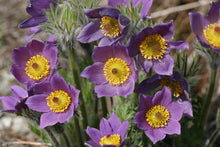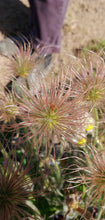Pasque Flower is an herbaceous perennial, native to Europe that is otherwise known as Wind or Easter Flower, or Purple Cowbell. It is a hardy plant, tolerating temperatures down to around -4°F. The large, beautiful purple flowers which emerge early in the spring before most plants are stirring, will bring a smile to your face, and makes Pasque flower an ideal companion for many early spring blooming bulbs. The beautiful purple flowers yield a green dye used in the colouring of Easter eggs.
The majority of the leaves, covered with silky, silvery hairs, develop after the flowers, the latter giving rise to upright, unique looking, feathery, silky seed-heads.
Plants prefer full sun and dryish or moist but well-drained soils. Established plants are drought tolerant. The seeds are sown on a moist medium, barely covered, tamped securely, and kept cool and moist. Pasque flower is generally a slow germinator, with results varying from 30 to 90 days. When the seedlings are large enough to handle, prick them out into individual pots for the first year’s growth.
Good success comes from root propagation, taking root cuttings in the early winter and potting them up in a mixture of peat and sand. Initially slow growing, Pulsatilla can be a long-lived plant, the clump enlarging every year, with more showy blooms each year.
The plant is harvested soon after flowering and is slightly toxic, with the toxins being dissipated by heat or by drying down the plant.
It is a low dose medicinal and needs to be treated with great respect! Taken internally, it helps in the treatment of female nervous exhaustion, pre-menstrual syndrome, inflammations of the reproductive organs, bacterial skin infections neuralgia, tension headaches, insomnia, septicaemia, asthmatic cough, whooping cough, and bronchitis. The tincture is also beneficial in correcting disorders of the respiratory and digestive passage mucous membranes.
Externally, it can be used to treat eye conditions such as cataracts, glaucoma and diseases of the retina.
The plant has become rare in its natural environment, due partly to over-collecting and also habitat loss. All the more reason to include this beautiful plant in your garden plans.
Approx. 40 seeds




